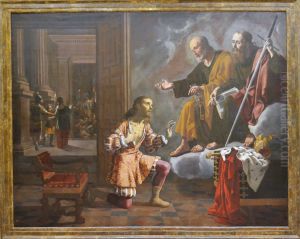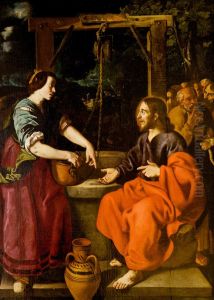Jeronimo Jacinto De Espinosa Paintings
Jeronimo Jacinto de Espinosa was a prominent Spanish painter of the Baroque era, born in 1600 in Cocentaina, now in the province of Alicante, Spain. He was baptized on May 6, 1600, in the town of his birth. Espinosa's early life was spent in the Valencian region, and it is there that he developed his artistic career. Despite the fact that little is known about his training, it is believed that he was greatly influenced by the work of Francisco Ribalta, a leading Spanish Baroque painter of the time, with whom he may have studied or collaborated. Espinosa is sometimes referred to as a follower of Ribalta due to the stylistic similarities in their work.
Espinosa's art is characterized by its use of dramatic lighting, strong chiaroscuro effects, and a rich, warm palette. He was skilled at religious scenes, which were a primary subject matter for many Baroque artists due to the Counter-Reformation's emphasis on religious art that was emotionally engaging and could serve as a tool for religious education and conversion. Espinosa's paintings often depict biblical scenes, saints, and the life of Christ with a sense of realism and emotional depth.
Throughout his career, Jeronimo Jacinto de Espinosa was highly regarded in the Valencia area, receiving numerous commissions for altarpieces and other religious works for churches and convents. Despite his regional success, he did not achieve the same level of fame as some of his contemporaries, such as Velázquez or Zurbarán, and as a result, he remained relatively unknown outside of Valencia during his lifetime.
Jeronimo Jacinto de Espinosa's work was rediscovered and reevaluated in the later centuries, and he is now recognized as one of the significant contributors to Spanish Baroque painting. His paintings can be found in various museums and churches in Spain, and they are appreciated for their technical skill and contribution to the Spanish artistic heritage. Espinosa died in 1667 in Valencia, leaving behind a body of work that continues to be studied and admired for its beauty and historical value.





